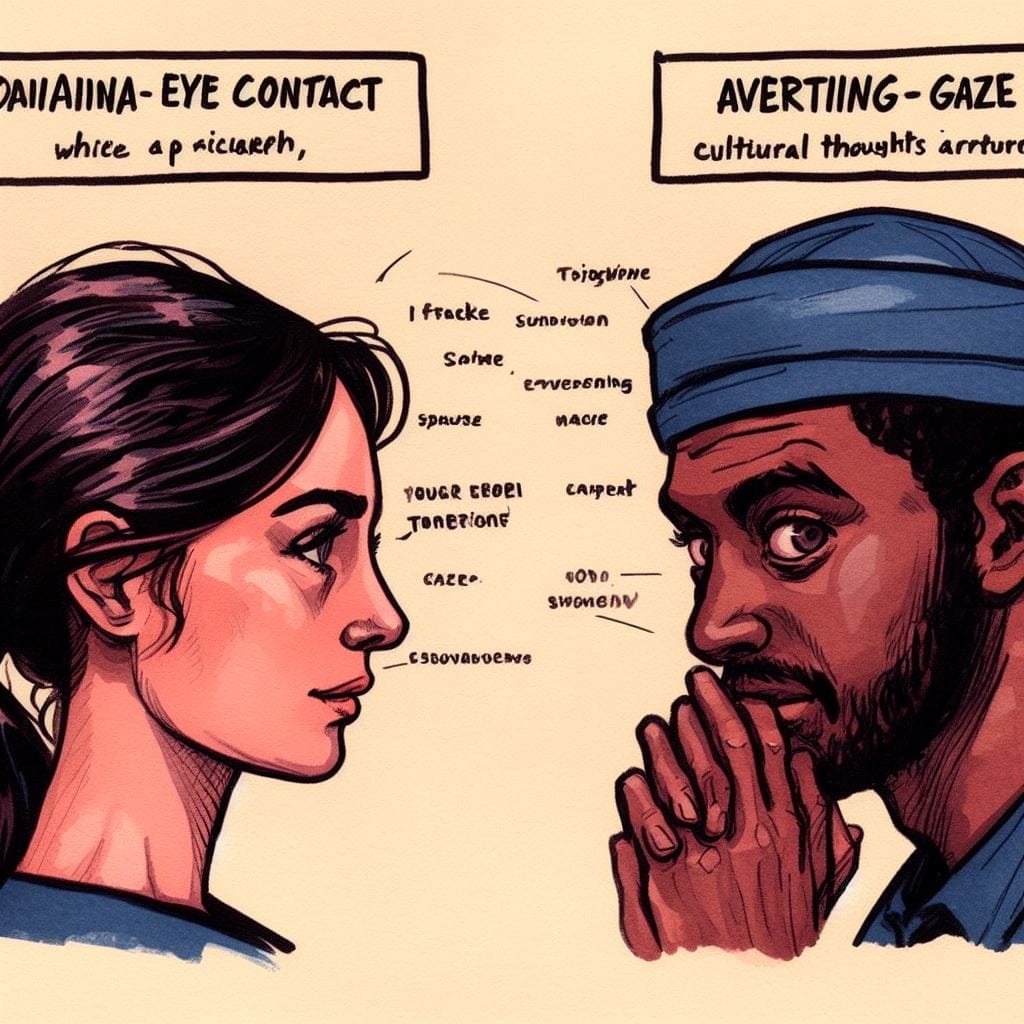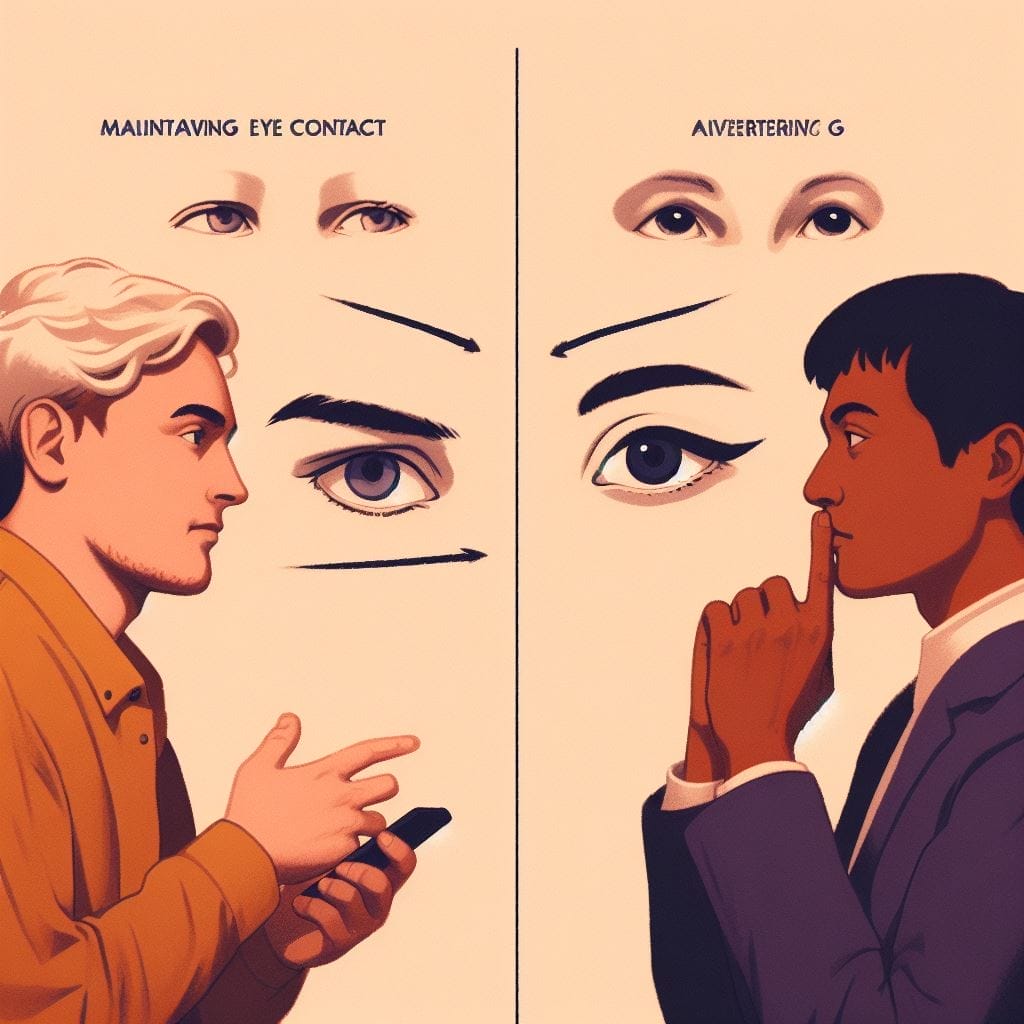Introduction
When people interact, body language and nonverbal communication can be more important than words. Imagine a situation where small actions, like raising an eyebrow or smiling briefly, can convey a story without words. Understanding how human beings flow and explicit themselves is vital for connecting with others. So today in this guide you will learn ‘Can Body Language Be Misinterpreted?
To recognize communique better, we want to recognize the importance of frame language. Body language is like a conductor for human expression. In this study, we’ll examine how nonverbal cues affect our interactions and communication.
Come with me on a charming adventure. We will learn how to recognize gestures, facial expressions, and eye touch. As we begin this journey, we need to be cautious of misunderstandings that may cause verbal exchange problems.
In this journey, we want to explain nonverbal signals and the challenges they bring. Cultural differences, individual variations, and emotions affect our interactions. Get ready as we explore human expression, decoding body language in a world full of hidden stories.
Key Takeaways
- Learn how to interpret nonverbal cues, which include facial expressions and gestures, which bring messages without words.
- Explore the relationship between verbal and nonverbal conversation and how they work together. Learn how they enhance conversations. Understand the significance of eye contact as a powerful tool in this dance.
- Be aware of potential misinterpretations. Learn how to avoid misinterpreting things. Recognize the cultural differences, individual variations, and emotional contexts that can influence the reading of nonverbal signals.
- To communicate better, learn to listen, be aware of your body language, and promote open communication. Delve into the importance of cultural sensitivity in cross-cultural interactions.
- As you near the end of this journey, consider how body language and nonverbal communication create connections. Feel empowered to enhance your communication skills and perceive the subtle layers of human expression.

How to Read Body Language:
A. Definition and Examples of Body Language:
Body language is the way we specify our emotions, thoughts, and intentions through gestures and expressions. It is a language that everybody speaks, no matter lifestyle or language barriers. Through frame language, we exhibit our actual feelings, attitudes, and motivations. Through body language, we showcase our true emotions, attitudes, and motivations.
For instance, clenched fists or crossed palms might also say defensiveness or a closed-off attitude. , a comfortable posture, keeping eye touch, and open gestures carry friendliness and openness. These nonverbal cues can paint a bright photograph of someone’s inner country.
B. Importance of Studying Nonverbal Cues in Communication:
Enhancing Communication:
Even though talking is important, understanding body language can improve our communication skills. By recognizing body language, we can understand hidden messages, connect with others, and build relationships.
Unveiling Honest Intentions:
Nonverbal indicators often provide diffused recommendations approximately someone’s proper intentions. It can help us discover sincerity, trustworthiness, and credibility. When you look at someone in the attention, it indicates you’re paying interest and being honest. But if you avoid eye touch, it can mean you’re uncomfortable or cheating.
Reducing Misunderstanding:
More than ninety of our communication is nonverbal, making it essential to take note of frame language. Misinterpretation of spoken phrases can bring about misunderstandings, battles, or neglected opportunities. We can better apprehend the message using analyzing body language with spoken language.
Facial Expressions as Windows to Emotions:
Our emotions show on our faces, and our expressions can reveal how. The face can reveal emotions through smiles and frowns, showing happiness or worry.
The Complexity of Nonverbal Communication
In our modern society, communication is digitized and remote, so we often don’t notice nonverbal cues. Nonverbal communication is a powerful way to bring messages without using words. It includes facial expressions, gestures, and posture. We will explore nonverbal cues, how they work with words, and the difficulty of understanding them.
I. The Multitude of Nonverbal Cues:
Nonverbal verbal exchange includes a big selection of forms, inclusive of body language, facial expressions, gestures, and posture. These cues are the approaches people use their bodies to convey messages, emotions, and feelings. Moving your body can emphasize your tone, help understanding, and enhance nonverbal communication.
II. The Significance of Nonverbal Communication:
As human beings, our earliest form of communication becomes via nonverbal cues. Long in the past, our ancestors depended on basic feelings to stay safe from extraordinary dangers. Being capable of understanding someone’s body language can be a count of life or death. It allows us to decide if a person or a situation is secure or risky.
III. Interplay between Verbal and Nonverbal Communication:
While words are powerful communication tools, they are not always enough to convey the whole message or capture nuances. This is where nonverbal cues step in! We often rely on body language, facial expressions, and nonverbal cues to support or highlight our words. The combination of verbal and nonverbal cues creates a more correct expertise.
IV. The Complexity of Accurate Interpretation:
Interpreting nonverbal communication can be challenging. Each culture has its way of understanding nonverbal cues, which can lead to misunderstandings. The complexity can cause misunderstandings, affecting personal and professional relationships.
V. The Consequences of Miscommunication:
Misunderstandings, arguments, and poor communication can arise from misreading or misinterpreting nonverbal signs. It could be hard to trust or comprehend someone if you misinterpret their behavior. Thus, it’s vital to be aware of our very own frame language and remain aware of cultural variations.

Factors Contributing to Misinterpretation
Miscommunication can arise in various bureaucracies, with misunderstandings bobbing up due to language barriers or specific interpretations of verbal cues. But, one factor that is neglected is the large effect of nonverbal verbal exchange and body language on our interactions.
In this phase, we will examine why misinterpretation happens. We will also discuss the significance of information and nonverbal cues in today’s society.
I. Cultural Differences in Body Language:
A. The Impact of Cultural Norms on Body Language:
Body language differs from one culture to another. Cultural practices, customs, and traditions shape the way people interpret and use nonverbal cues. An easy gesture that indicates politeness in a single tradition is considered offensive or impolite in any other.
If we don’t know these cultural customs, misinterpret body language and misunderstand each other.
B. Overcoming Misinterpretation Through Awareness:
To avoid misreading nonverbal communication, it’s miles critical to remember the cultural context. We can understand and appreciate how others use body language by learning cultural norms. This improves communication and promotes cross-cultural understanding.
II. Individual Variations in Nonverbal Cues:
A. The Complexity of Interpreting Nonverbal Cues:
While it’s miles crucial to not forget cultural variations, character variations in nonverbal cues complicate the interpretation technique. People explicit themselves in exclusive approaches, the use of gestures, facial expressions, and frame language.
It’s essential to recognize those cues to keep away from misinterpretation. Factors inclusive of persona, upbringing, and private reports contribute to these individual versions.
B. Importance of Self-Awareness:
Awareness of your body language is important whilst speaking with others. Think about how people may understand your body language and facial expressions when you talk to them. To keep away from misunderstandings and join better with others, combine your body language with your phrases.
III. Emotional Context and Its Impact on Interpretation:
A. Primitive Emotional Reactions that Shape Interpretation:
Body language and nonverbal cues have been ingrained in our evolution as humans. Our ancestors used their quick instincts to understand body language and determine if there were any risks. Since then, the world has changed, but our natural responses to nonverbal signals still come from our basic emotions.
B. The Need for Accurate Interpretation:
Even now, it’s crucial to grasp nonverbal cues, despite our unique modern-day challenges. When we misunderstand body language, it can affect how we see others and what they want.
Common Misinterpretations of Body Language
Misreading signals of interest or attraction:
One of the most regular misinterpretations of body language is mistaking pleasant conduct for romantic interest or appeal. It’s essential to realize that nonverbal cues can vary based totally on context and cultural background.
Before coming to conclusions, it’s essential to consider different things like how they act and speak. Rather than relying on nonverbal cues, it’s better to have open and honest communication to make clear intentions.
Mistaking trepidation for deceit:
Another commonplace misinterpretation of body language is associating anxiousness with deceit or dishonesty. Nervousness can appear in diverse ways, which include fidgeting, keeping eye touch, or talking. But, those behaviors are not indicative of mendacity.
Nervousness regularly stems from factors like social anxiety or the worry of making a mistake. Instead of assuming a person is lying primarily based on their frame language, it’s critical to bear in mind other factors. Keep verbal exchanges open and deliver them the gain of the doubt.
Misinterpreting gestural cues in extraordinary contexts:
Body language and gestures can mean different things depending on the culture and situation. What is taken into consideration appropriately in one cultural setting may not hold identical significance in every other. In Western cultures, crossed fingers can mean defensiveness or a war of words.
Yet, in certain Asian cultures, it can show attentiveness. The key is to be aware of these cultural variations and avoid making hasty assumptions. It’s continually higher to invite for clarification than to jump to conclusions based on nonverbal cues.
Potential Aspects of Misinterpreting Body Language
Here’s a detailed table highlighting various aspects of body language that can be misinterpreted:
| Aspect | Potential Misinterpretation |
|---|---|
| 1. Eye Contact | Misinterpretation: Smiling is equated with genuine happiness. |
| Insight: Cultural differences may influence eye contact. | |
| 2. Facial Expressions | Insight: This may simply indicate discomfort or shyness. |
| Insight: Smiles can mask discomfort or nervousness. | |
| 3. Posture | Misinterpretation: Closed posture as a sign of hostility. |
| Misinterpretation: Mirroring is taken as a genuine connection. | |
| 4. Gestures | Misinterpretation: Aggressive gestures misconstrued. |
| Insight: Cultural nuances play a role in gesture meanings. | |
| 5. Proximity | Misinterpretation: Friendly touch is perceived as flirtation. |
| Insight: Proximity may be influenced by cultural norms. | |
| 6. Touch | Misinterpretation: Mirroring is taken as genuine connection. |
| Insight: Personal boundaries vary among individuals. | |
| 7. Mirroring | Misinterpretation: Nervous habits are seen as dishonesty. |
| Insight: People may mirror unconsciously or deliberately. | |
| 8. Nervous Habits | Misinterpretation: Brief expressions are overlooked or misread. |
| Insight: Anxiety or stress can manifest in various ways. | |
| 9. Tone of Voice | Misinterpretation: Tone misjudged, affecting communication. |
| Insight: Cultural and emotional context impact tone. | |
| 10. Microexpressions | Misinterpretation: Inconsistencies are seen as deceitfulness. |
| Insight: Microexpressions convey subtle, fleeting emotions. | |
| 11. Consistency | Misinterpretation: Mirroring is taken as a genuine connection. |
| Insight: Individuals may display mixed signals at times. | |
| 12. Context | Misinterpretation: Lack of context leads to inaccurate readings. |
| Insight: Consider the environment and specific circumstances. |

Overcoming Misinterpretation
Misinterpreting how someone’s movements or acts can motivate us to make incorrect assumptions approximately their feelings or desires. Body language becomes our earliest shape of non-verbal verbal exchange, says creator Carol Kinsey Goman. It still affects our interactions today. Yet, interpreting non-verbal cues is not always straightforward.
Developing Active Listening Skills:
Active listening manner not listening to, but also being attentive to body language and staying engaged. By keeping eye touch, nodding, and providing verbal affirmations, you display to the speaker that you are engaged. This creates an open and alluring surrounding for powerful verbal exchange to flourish.
Increasing Self-cognizance of Body Language:
Understanding our frame language is vital, as “movements communicate louder than words.” Our facial expressions, gestures, and posture can bring our intentions and feelings. To prevent confusion, we need to be aware of our nonverbal cues when speaking to human beings.
Seeking Clarification and Open Communication:
When doubtful, by no means hesitate to seek clarification. If you don’t recognize something, ask questions or repeat what the character said to make sure you understand. To have open communication, proportion your thoughts and emotions to avoid misunderstandings.
Cross-cultural Communication’s Cultural Sensitivity:
In a various international society, move-cultural conversation plays an important role. Cultural norms and body language cues can also range from one subculture to another. We need to be sensitive, find out about unique customs, and regulate how we talk. By doing so, we bridge the distance in know-how and reduce the chances of misinterpretation.
Getting Through the Maze: Getting Past Misunderstanding
Misinterpretation can be like a fog, clouding communication and knowledge. Let’s embark on a journey to get to the bottom of the complexities and create a roadmap for overcoming misinterpretations of diverse elements of existence.
A Comprehensive Aspects Table
| Aspect | Description |
|---|---|
| 1. Verbal Communication | Potential Misinterpretation: Tone and choice of words can lead to confusion. Overcoming Strategy: Clarify intentions, ask for feedback, and use active listening to ensure mutual understanding. |
| 2. Non-Verbal Cues | Potential Misinterpretation: Body language may convey unintended messages. Overcoming Strategy: Be mindful of gestures, maintain an open posture, and consider cultural differences. |
| 3. Written Communication | Potential Misinterpretation: Ambiguity in written messages can lead to confusion. Overcoming Strategy: Use clear language, provide context, and encourage questions for clarification. |
| 4. Cultural Sensitivity | Potential Misinterpretation: Cultural nuances may result in misunderstandings. Overcoming Strategy: Educate oneself on diverse cultures, seek cultural context, and foster an inclusive communication environment. |
| 5. Emotional Expression | Potential Misinterpretation: Varied emotional responses can be misconstrued. Overcoming Strategy: Encourage open dialogue about emotions, validate feelings, and express empathy. |
| 6. Intent vs. Impact | Potential Misinterpretation: Intentions may differ from the perceived impact. Overcoming Strategy: Foster a culture of transparent communication, encourage feedback, and acknowledge differing perspectives. |
| 7. Feedback Dynamics | Potential Misinterpretation: Feedback may be misunderstood or taken personally. Overcoming Strategy: Provide constructive feedback, emphasize learning, and create a feedback loop for clarification. |
| 8. Contextual Awareness | Potential Misinterpretation: Lack of context can lead to misjudgments. Overcoming Strategy: Provide sufficient context, encourage questions, and ensure shared information about the scenario. |
| 9. Assumptions and Stereotypes | Potential Misinterpretation: Assumptions based on stereotypes can create biases. Overcoming Strategy: Challenge assumptions, sell diversity, and foster surroundings of inclusivity. |
| 10. Active Listening | Potential Misinterpretation: Failure to actively listen can result in misunderstandings. Overcoming Strategy: Practice active listening, ask clarifying questions, and paraphrase to confirm information. |
Decoding the Unspoken: My Journey
In the world of interpreting body language, my adventure mirrors the twists and turns of a fascinating narrative. As an avid observer of human interactions, I determined myself drawn to the diffused nuances that define our unspoken communication.
A Tale of Cultural Quirks
On a journey through numerous cultures, I encountered a peculiar scenario that left an indelible mark on my understanding of frame language. In a bustling marketplace in Tokyo, a friendly smile and a nod have been regularly perceived as symptoms of politeness. However, my attempts to replicate these gestures in a busy New York subway led to perplexed stares rather than reciprocal nods.
In this cross-cultural dance, I realized the profound impact of context and cultural norms on interpreting non-verbal cues. A raised eyebrow may signify surprise in one setting and skepticism in another. This experience underscored the importance of shedding preconceived notions and embracing the cultural kaleidoscope that shapes our body language.
Lessons Learned
Through these reviews, I’ve come to realize the problematic tapestry of human expression. Misinterpretations, even though inevitable, function as stepping stones in the direction of cultural sensitivity and open-mindedness. Navigating the labyrinth of body language calls for a willingness to examine, adapt, and rejoice in the richness of diversity.
IIn my adventure, I’ve found that decoding the unspoken is not a static talent but a dynamic procedure of continuous increase. Each interaction offers a chance to refine our understanding, break down stereotypes, and foster genuine connections.
So, allow us to embark on this shared adventure of interpreting the unspoken, weaving a story that transcends borders and unites us inside the general language of human connection.
FAQs: Can Body Language Be Misinterpreted?
How can misinterpreting nonverbal communication, especially when people misread your body language, impact the importance of nonverbal communication in various interpersonal relationships?
Misinterpreting nonverbal cues, consisting of failing to make eye touch or misunderstanding the subtle sorts of frame language, can decrease the effectiveness of interpersonal communication. In today’s society, body language is important.
If you misread it, you may get the wrong idea about unchanged emotions in human interactions. Recognizing the importance of interpreting body language is essential for fostering meaningful connections and avoiding misunderstandings.
How can people improve their nonverbal communication? This ensures that body language cues are read and reduces misinterpretation of nonverbal cues.
Improving nonverbal communication involves heightened self-awareness of your body language. People can communicate better by paying attention to body language and cultural norms.
Developing the split-second ability to recognize if a person is conveying a benign or dangerous message is crucial. This process is based on old instincts and helps people understand nonverbal signals to communicate better.
How does misinterpreting nonverbal cues in professional settings affect communication dynamics? What strategies can individuals use to reduce misunderstandings?
Misinterpreting nonverbal verbal exchange in professional settings can disrupt the dynamics of communique, main to misjudgments and miscommunications. Being aware of your very own frame language and recognizing the importance of nonverbal cues can assist in heading off misreads. Understanding that different cultural norms may influence behavioral cues is vital.
Being aware of others’ nonverbal signals helps create an accurate and harmonious work environment.
Can you provide examples of how misunderstanding nonverbal cues can hurt relationships and how to prevent it?
Misunderstanding nonverbal cues often affects relationships in a big way. For example, failing to interpret averted eyes or concealed hands could lead to misunderstandings. In the past, being able to quickly tell if someone had something dangerous was crucial for survival.
To avoid misreads, people may be aware of their body language, cultural differences, and nonverbal signals.
Considering the importance of nonverbal communication in everyday interactions, what position does self-awareness play in preventing the misinterpretation of nonverbal cues, and how can people enhance their capacity to examine frame language appropriately in exclusive social contexts?
Self-cognizance is paramount in preventing the misinterpretation of nonverbal cues. We should recognize that our ancestors faced different challenges. This helps emphasize the need for increased awareness. To better understand body language, it helps to know that our thoughts are shaped by emotions.
To communicate, it’s important to be aware of body language and cultural norms. Also, practice interpreting behavior without misjudging.
Conclusion: Can Body Language Be Misinterpreted?
In the intricate dance of human communication, body language emerges as a multifaceted and, at times, perplexing partner. As we resolve the threads of this non-verbal tapestry, it turns into evident that the street to correct interpretation is laden with demanding situations and nuances. Here’s a concise recap:
- Complexity Unveiled: Body language, encumbered with cultural nuances and personal variations, showcases the tricky nature of human expression.
- Pitfalls of Misinterpretation: The perilous terrain of misreading feelings, encouraged by using gender stereotypes and biases, poses a huge risk to effective verbal exchange.
- Cultural Crossroads: Across diverse cultures, the meanings attached to gestures and expressions diverge, highlighting the significance of cultural sensitivity in decoding non-verbal cues.
- Navigating the Labyrinth: To navigate the labyrinth of capability misinterpretations, fostering awareness, sensitivity, and open-mindedness emerges as the key.
In conclusion, the world of body language proves to be both fascinating and difficult. As we embark on this adventure of expertise, allow us to recollect that true communique extends beyond mere gestures. It calls for active listening, cultural recognition, and a harmonious combination of verbal and non-verbal cues.
Take the Leap!
Embark on a journey to resolve the complexities of human expression. Cultivate attention, celebrate range, and beautify your verbal exchange prowess. Join us in deciphering the unspoken and fostering a world of actual information. Communication is an artwork; allow’s paint a masterpiece collectively!

Sarah Andrews’ work on relationships is informed by a breadth of experience and a strong interest in human nature. Sarah, who holds a Psychology degree and has a good eye for nuances, delves into the complexity of communication and emotion, delivering insightful insights for readers seeking personal growth and emotional pleasure. Sarah hopes that her empathic approach and insightful suggestions will motivate readers to understand themselves and their relationships better.
